Introduction
Transmissible Venereal Tumor (TVT) is similar to cancer and this occurs in both the sexes of a dog but most commonly in Female dogs. TVT also known as Infectious Sarcoma, Venereal granuloma or Stickers tumor commonly occurs in sexually active and mature adult dogs usually of 1-5 years of age.
Transmissible Venereal Tumor (TVT) is a contagious cancer transmitted through mating or contact with infected areas. It appears as cauliflower-like growths on genitals, mouth, or nose, causing bleeding, difficulty urinating, and weakness.
TVT spreads via malignant cell transfer (not viruses/bacteria) and is diagnosed through cytology or biopsy. Treatment involves weekly chemotherapy (vincristine) for 4-7 weeks, with high success rates. Prevention includes spaying or neutering, supervised breeding, and avoiding stray dogs. While TVT doesn’t infect humans, prompt veterinary care is crucial. Early detection ensures effective treatment and reduces recurrence risks. For suspected cases, consult vet immediately.
What is Canine Transmissible Venereal Tumor (TVT)?
Tumor/ Cancer is an uncontrolled division of cells that grow into a solid mass with a high amount of blood supply. In this case of TVT, the tumour mass is generally located at the vagina in bitches and at the penile region in the case of male dogs. It is a Neoplastic disease which usually arises from the dysregulated growth of cells called histiocytes i.e. skin histiocytes. TVT Cells grow in an uncontrolled way into a hard mass. This mass can be felt as similar to a cauliflower growth. This growth gradually expands in size.
This blog post will provide an overview of TVT, including its symptoms, causes, signs to observe, prevention, and treatment options.
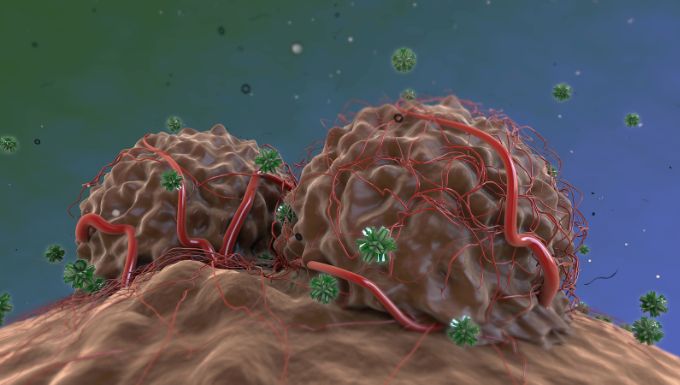
Key Facts About TVT
- Origin: TVT is one of the oldest known cancers, dating back thousands of years, likely originating in a single canid ancestor.
- Prevalence: Common in tropical and subtropical regions, including parts of Central and South America, Asia, Africa, and the Caribbean. It’s less common in North America due to widespread spaying/neutering.
- Affected Dogs: Sexually active, unneutered dogs, especially strays or free-roaming mixed breeds, are most at risk. Both males and females can be affected, though females may show higher prevalence.
Symptoms of TVT in Dogs
- Deformation of external genitalia due to the growth of solid, cauliflower-like structures ranging from 5 mm to 10 cm wide.
- Haemorrhagic discharges due to the heavy blood supply to the tumour. This has to be differentiated from the normal proestrus bleeding.
- Blood spotting is seen wherever the dog sits and stands due to bleeding, discharge, swelling, or ulceration in the affected areas.
- Difficulty in Urination and Defecation.
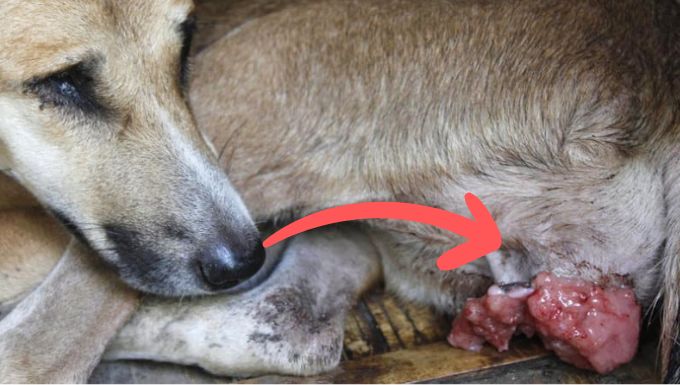
Causes and Transmission of TVT
The TVT tumour cells which are primarily present in the lining of the skin of either sex get transplanted or transferred to the other during coitus i.e. When a male dog has TVT, on crossing with a female transfers the TVT cells onto the lining of the vagina. These cells grow in an uncontrolled way into a hard mass. This mass can be felt as similar to a cauliflower growth. This growth gradually expands in size.
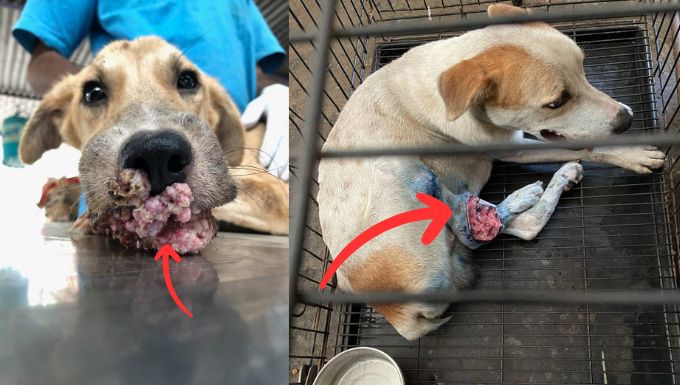
Transmissible Venereal Tumor (TVT) can also be transmitted by licking and sniffing the affected areas of TVT-positive dogs. In this case, the tumour may occur on the skin, nasal, oral cavities and anal mucosa. Street dogs have a high possibility of TVT occurrence, so unwanted crossings with them should be avoided.
TVT is not caused by a virus or bacteria, but rather by the transfer of malignant cells from one dog to another.
Transmission
TVT cells get transplanted to the other dogs most commonly through coitus or by other routes like sniffing or licking of the affected areas. The tumour growth reappears after 15-60 days of transplant. Hence, TVT occurs by unwanted mating mostly by street dogs and uncontrolled breeding.
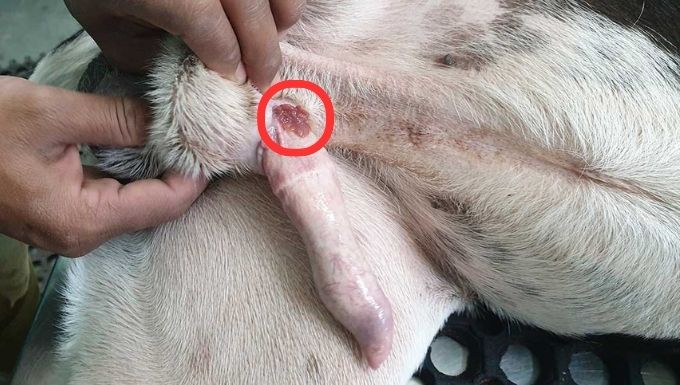
The tumour growth is mostly seen in the vaginal and vestibulovaginal region in the case of females and the penis in the case of males if coitus is the main cause of transmission. The tumour can also be seen in skin, oral, nasal mucosa, anal mucosa, gluteal region and maxilla if the cause of transmission is through other routes.
Signs to observe for TVT
- Continuous Bleeding from the Vagina – This shouldn’t be confused with the normal menstrual heat bleed condition of the bitch which usually occurs in the interval of every 6-8 months. The menstrual heat bleeding occurs drop by drop and it usually lasts for 9-12 days whereas in the case of TVT, the bleeding is more than the normal condition and it continues to increase as the condition worsens, blood spottings are seen wherever the dog sits and stand.
- Visible tumour growth – The cauliflower-like tumour growth can be seen externally. This is possible usually in severe cases
- Difficulty in Urination and Defecation – Tumors can interfere with normal urination and defecation process reducing the lumen wall.
- General Weakness – The affected dogs show laziness and have less energy.
Sometimes in males, the pet parents may notice blood in urine. TVT can be one of the causes for this sign as the tumour occurs in the penis region.
Pet parents should regularly examine their pets for any abnormalities and seek veterinary attention if any suspicious signs are noticed.
As a responsible pet parent, it is advised to be aware of this contagious and most common sexually transmitted disease This benefits the welfare of the voiceless and also the Pet parents.
Diagnosis of TVT in Dogs
Accurate diagnosis is essential to differentiate TVT from other tumors, such as mast cell tumors or sarcomas. Veterinarians use the following methods:
- Physical Examination: Checking for characteristic cauliflower-like masses on the genitalia or other areas.
- Cytology: Aspiration of tumor cells for microscopic examination to confirm TVT’s round cell morphology.
- Biopsy and Histology: A tissue sample may be analyzed to rule out other cancers and confirm TVT.
- Molecular Testing: PCR to detect the LINE-1 insertion near the c-myc gene, a diagnostic marker for TVT.
Early diagnosis improves treatment outcomes, so don’t delay seeking veterinary care if you suspect TVT.
Treatment of TVT
TVT can be treated with the utmost care and guidance of a veterinarian. There are different treatment options. Sometimes TVT can recur even after a cure. In this case, it completely depends upon the Immunity of the pet
Chemotherapy
- Inj.Vincristine sulfate 0.025mg/kg can be administered intravenously slowly on dilution with Normal saline weekly once for 3-5 weeks consecutively without breaks in between. This has a success rate. But sometimes there will be side-effects like Vomiting etc. The parent should be ready for the side effects too to get cured of TVT
- Inj. Methotrexate – 0.1 to 0.3 mg/kg BW orally daily for 10-15 days
- Vinblastine @0.1mg/kg I/V for 4-6 wks
- In resistant cases, it can be treated with Doxorubicin @30mg/m I/V with 3 applications every 21 days.
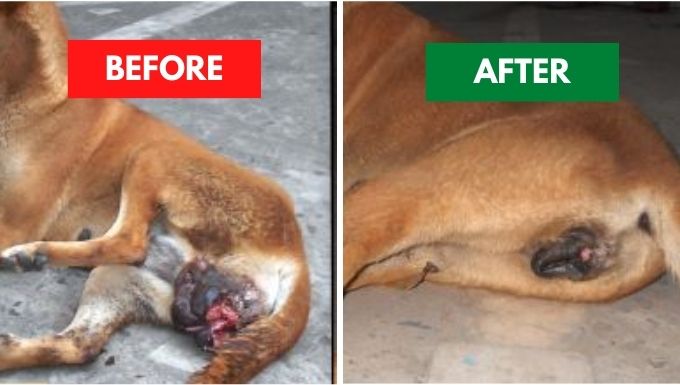
Surgical Management
Removal of the tumour by surgery is another option. But this is highly risky as the tumour has a high blood supply and before proceeding with surgery the complete condition is taken into consideration. surgical approach is generally not advisable.
Other treatment options include Radiation therapy & Cryotherapy
Prevention
- Spaying and neutering – This is one of the best methods of prevention and this not only reduces the risk of transmission but also has other health benefits for your pet.
- Supervised breeding – means preventing your pet from unwanted and unnecessary breeding mainly with street dogs. Breeding should be done under your supervision after knowing the health history of the other dog. keeping dogs on a leash and avoiding contact with stray or unknown dogs.
- Regular health checkups– This can help in the early identification of TVT in case of suspected cases and increase the chances of successful treatment.
PREVENTION IS BETTER THAN CURE
Frequently Asked Questions (FAQs) About TVT in Dogs
Is TVT contagious to humans or other pets?
No, TVT is not transmissible to humans or other species. However, wear gloves when handling affected areas to avoid irritation.
Can neutered dogs get TVT?
Yes, though neutering reduces the risk by limiting mating. Neutered dogs can still contract TVT through licking or sniffing affected areas.
How long does TVT treatment take?
Chemotherapy typically takes 4-7 weeks, with weekly vincristine injections. Full remission is common after this period.
Can TVT reoccur after treatment?
Recurrence is rare with proper chemotherapy but possible if treatment is incomplete or if the dog is re-exposed to infected animals.
Conclusion
Transmissible Venereal Tumor (TVT), a tumour condition similar to cancer, occurs in both male and female dogs, with female dogs being more commonly affected. It is caused by the transfer of malignant cells from one dog to another, primarily through coitus, and can also be transmitted through licking or sniffing of affected areas. Symptoms include deformation of the external genitalia, hemorrhagic discharges, blood spotting, and difficulty in urination and defecation.
Prevention methods include spaying or neutering, supervised breeding, and regular health check-ups. Diagnosis is done through symptoms, crossing history, physical examination, and tissue biopsy. Treatment options include chemotherapy with Vincristine sulfate, Methotrexate, Vinblastine, and Doxorubicin. surgery and radiation therapy can also be done, but recurrence can occur depending on the pet’s immunity. Treatment should be done under the guidance of a veterinarian.
About Author
Dr. M.Aashritha, B.V.Sc & AH
Veterinary Doctor Graduated from PVNRTVU

